Legal Requirements for Building & Construction CERT IV Projects
VerifiedAdded on 2023/05/29
|9
|1915
|313
Homework Assignment
AI Summary
This assignment focuses on the legal requirements applicable to building and construction projects, addressing key areas such as business registration, builder's license obligations, the importance of obtaining necessary approvals, and the scope of a low-rise residential builder's license. It emphasizes effective communication strategies for overcoming language and cultural barriers, the legal responsibilities when presenting contracts to clients, and the critical role of occupational health and safety (OHS) requirements, including risk management plans. Furthermore, the assignment covers the significance of site safety plans, environmental impact assessments, understanding construction contract terms, payroll obligations, and various insurance requirements. It also highlights the paramount responsibility of the registered builder for site safety, the importance of adhering to the BCA/NCC, and the legal implications of not paying employee superannuation. The assignment concludes by stressing the importance of written communication in dispute resolution, managing tax and superannuation obligations, seeking legal advice when needed, and understanding the qualifications required for obtaining a builder's license.
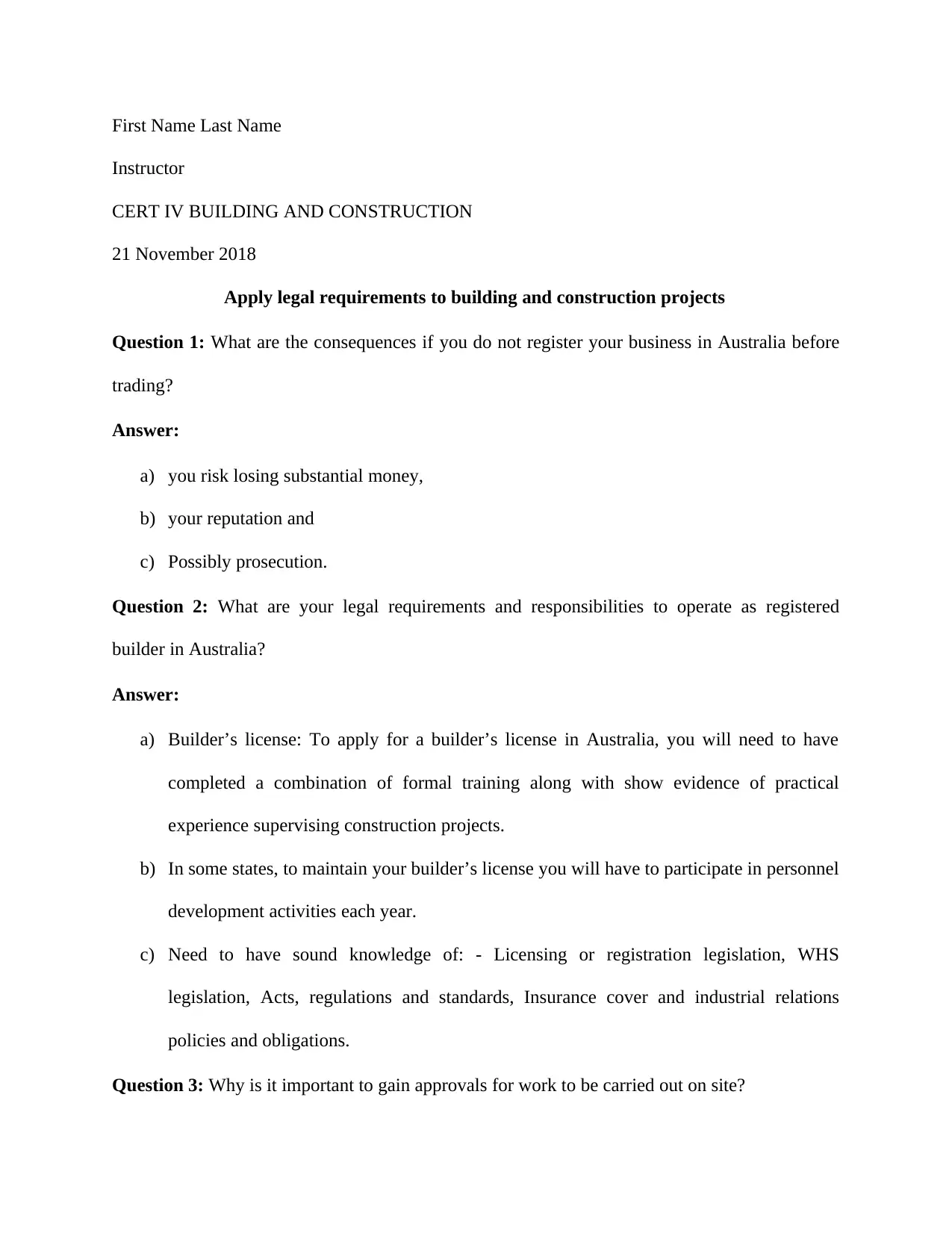
First Name Last Name
Instructor
CERT IV BUILDING AND CONSTRUCTION
21 November 2018
Apply legal requirements to building and construction projects
Question 1: What are the consequences if you do not register your business in Australia before
trading?
Answer:
a) you risk losing substantial money,
b) your reputation and
c) Possibly prosecution.
Question 2: What are your legal requirements and responsibilities to operate as registered
builder in Australia?
Answer:
a) Builder’s license: To apply for a builder’s license in Australia, you will need to have
completed a combination of formal training along with show evidence of practical
experience supervising construction projects.
b) In some states, to maintain your builder’s license you will have to participate in personnel
development activities each year.
c) Need to have sound knowledge of: - Licensing or registration legislation, WHS
legislation, Acts, regulations and standards, Insurance cover and industrial relations
policies and obligations.
Question 3: Why is it important to gain approvals for work to be carried out on site?
Instructor
CERT IV BUILDING AND CONSTRUCTION
21 November 2018
Apply legal requirements to building and construction projects
Question 1: What are the consequences if you do not register your business in Australia before
trading?
Answer:
a) you risk losing substantial money,
b) your reputation and
c) Possibly prosecution.
Question 2: What are your legal requirements and responsibilities to operate as registered
builder in Australia?
Answer:
a) Builder’s license: To apply for a builder’s license in Australia, you will need to have
completed a combination of formal training along with show evidence of practical
experience supervising construction projects.
b) In some states, to maintain your builder’s license you will have to participate in personnel
development activities each year.
c) Need to have sound knowledge of: - Licensing or registration legislation, WHS
legislation, Acts, regulations and standards, Insurance cover and industrial relations
policies and obligations.
Question 3: Why is it important to gain approvals for work to be carried out on site?
Paraphrase This Document
Need a fresh take? Get an instant paraphrase of this document with our AI Paraphraser
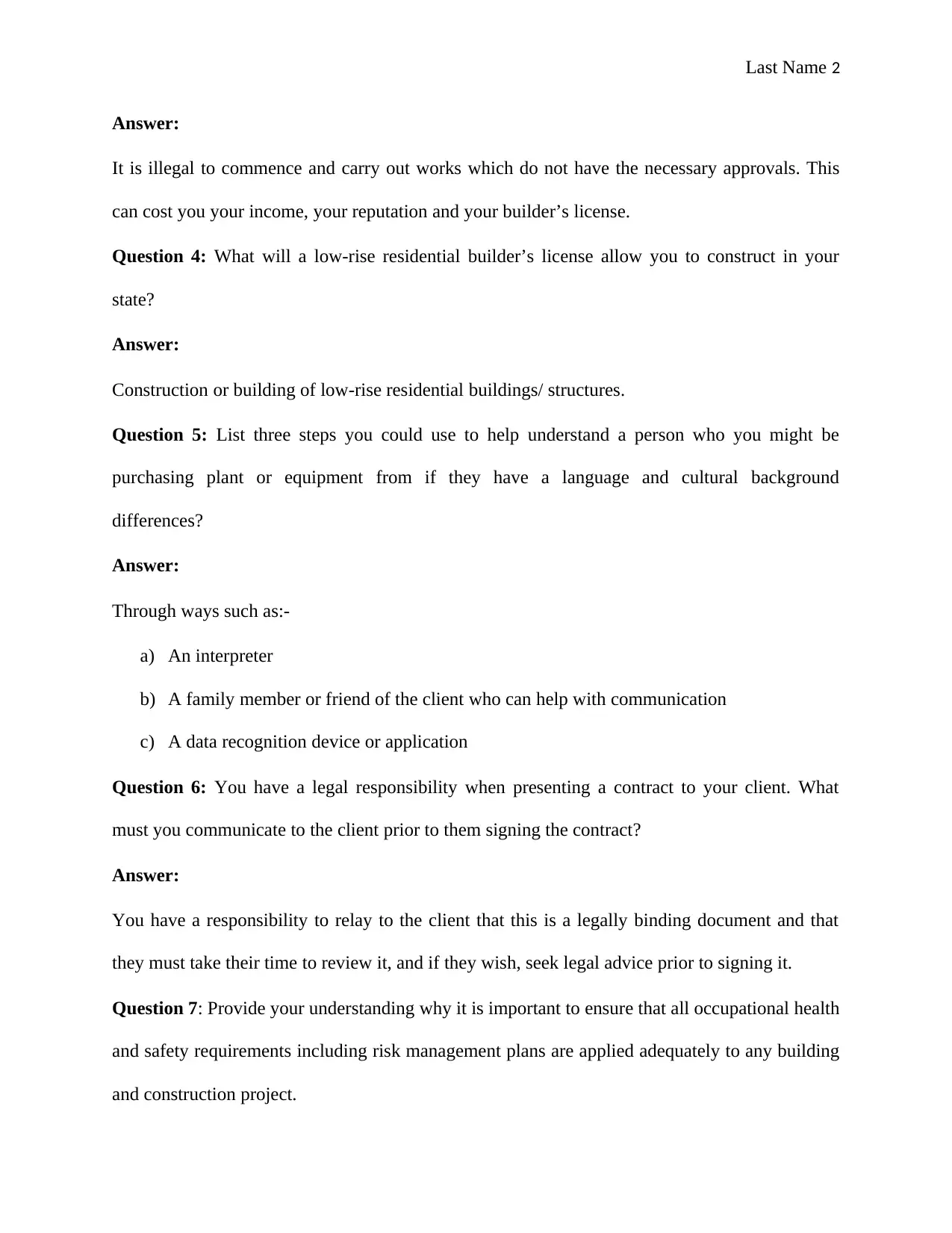
Last Name 2
Answer:
It is illegal to commence and carry out works which do not have the necessary approvals. This
can cost you your income, your reputation and your builder’s license.
Question 4: What will a low-rise residential builder’s license allow you to construct in your
state?
Answer:
Construction or building of low-rise residential buildings/ structures.
Question 5: List three steps you could use to help understand a person who you might be
purchasing plant or equipment from if they have a language and cultural background
differences?
Answer:
Through ways such as:-
a) An interpreter
b) A family member or friend of the client who can help with communication
c) A data recognition device or application
Question 6: You have a legal responsibility when presenting a contract to your client. What
must you communicate to the client prior to them signing the contract?
Answer:
You have a responsibility to relay to the client that this is a legally binding document and that
they must take their time to review it, and if they wish, seek legal advice prior to signing it.
Question 7: Provide your understanding why it is important to ensure that all occupational health
and safety requirements including risk management plans are applied adequately to any building
and construction project.
Answer:
It is illegal to commence and carry out works which do not have the necessary approvals. This
can cost you your income, your reputation and your builder’s license.
Question 4: What will a low-rise residential builder’s license allow you to construct in your
state?
Answer:
Construction or building of low-rise residential buildings/ structures.
Question 5: List three steps you could use to help understand a person who you might be
purchasing plant or equipment from if they have a language and cultural background
differences?
Answer:
Through ways such as:-
a) An interpreter
b) A family member or friend of the client who can help with communication
c) A data recognition device or application
Question 6: You have a legal responsibility when presenting a contract to your client. What
must you communicate to the client prior to them signing the contract?
Answer:
You have a responsibility to relay to the client that this is a legally binding document and that
they must take their time to review it, and if they wish, seek legal advice prior to signing it.
Question 7: Provide your understanding why it is important to ensure that all occupational health
and safety requirements including risk management plans are applied adequately to any building
and construction project.
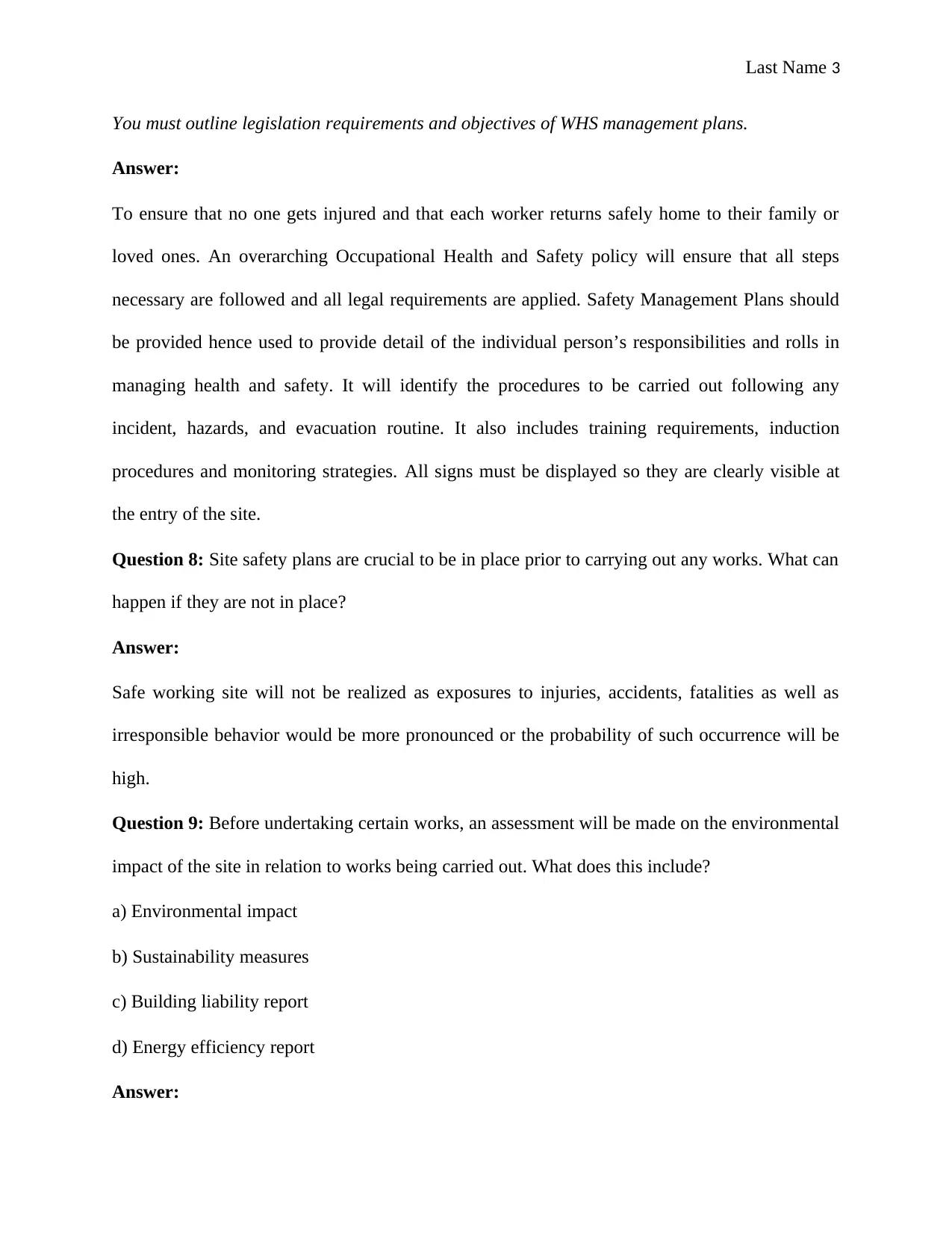
Last Name 3
You must outline legislation requirements and objectives of WHS management plans.
Answer:
To ensure that no one gets injured and that each worker returns safely home to their family or
loved ones. An overarching Occupational Health and Safety policy will ensure that all steps
necessary are followed and all legal requirements are applied. Safety Management Plans should
be provided hence used to provide detail of the individual person’s responsibilities and rolls in
managing health and safety. It will identify the procedures to be carried out following any
incident, hazards, and evacuation routine. It also includes training requirements, induction
procedures and monitoring strategies. All signs must be displayed so they are clearly visible at
the entry of the site.
Question 8: Site safety plans are crucial to be in place prior to carrying out any works. What can
happen if they are not in place?
Answer:
Safe working site will not be realized as exposures to injuries, accidents, fatalities as well as
irresponsible behavior would be more pronounced or the probability of such occurrence will be
high.
Question 9: Before undertaking certain works, an assessment will be made on the environmental
impact of the site in relation to works being carried out. What does this include?
a) Environmental impact
b) Sustainability measures
c) Building liability report
d) Energy efficiency report
Answer:
You must outline legislation requirements and objectives of WHS management plans.
Answer:
To ensure that no one gets injured and that each worker returns safely home to their family or
loved ones. An overarching Occupational Health and Safety policy will ensure that all steps
necessary are followed and all legal requirements are applied. Safety Management Plans should
be provided hence used to provide detail of the individual person’s responsibilities and rolls in
managing health and safety. It will identify the procedures to be carried out following any
incident, hazards, and evacuation routine. It also includes training requirements, induction
procedures and monitoring strategies. All signs must be displayed so they are clearly visible at
the entry of the site.
Question 8: Site safety plans are crucial to be in place prior to carrying out any works. What can
happen if they are not in place?
Answer:
Safe working site will not be realized as exposures to injuries, accidents, fatalities as well as
irresponsible behavior would be more pronounced or the probability of such occurrence will be
high.
Question 9: Before undertaking certain works, an assessment will be made on the environmental
impact of the site in relation to works being carried out. What does this include?
a) Environmental impact
b) Sustainability measures
c) Building liability report
d) Energy efficiency report
Answer:
⊘ This is a preview!⊘
Do you want full access?
Subscribe today to unlock all pages.

Trusted by 1+ million students worldwide
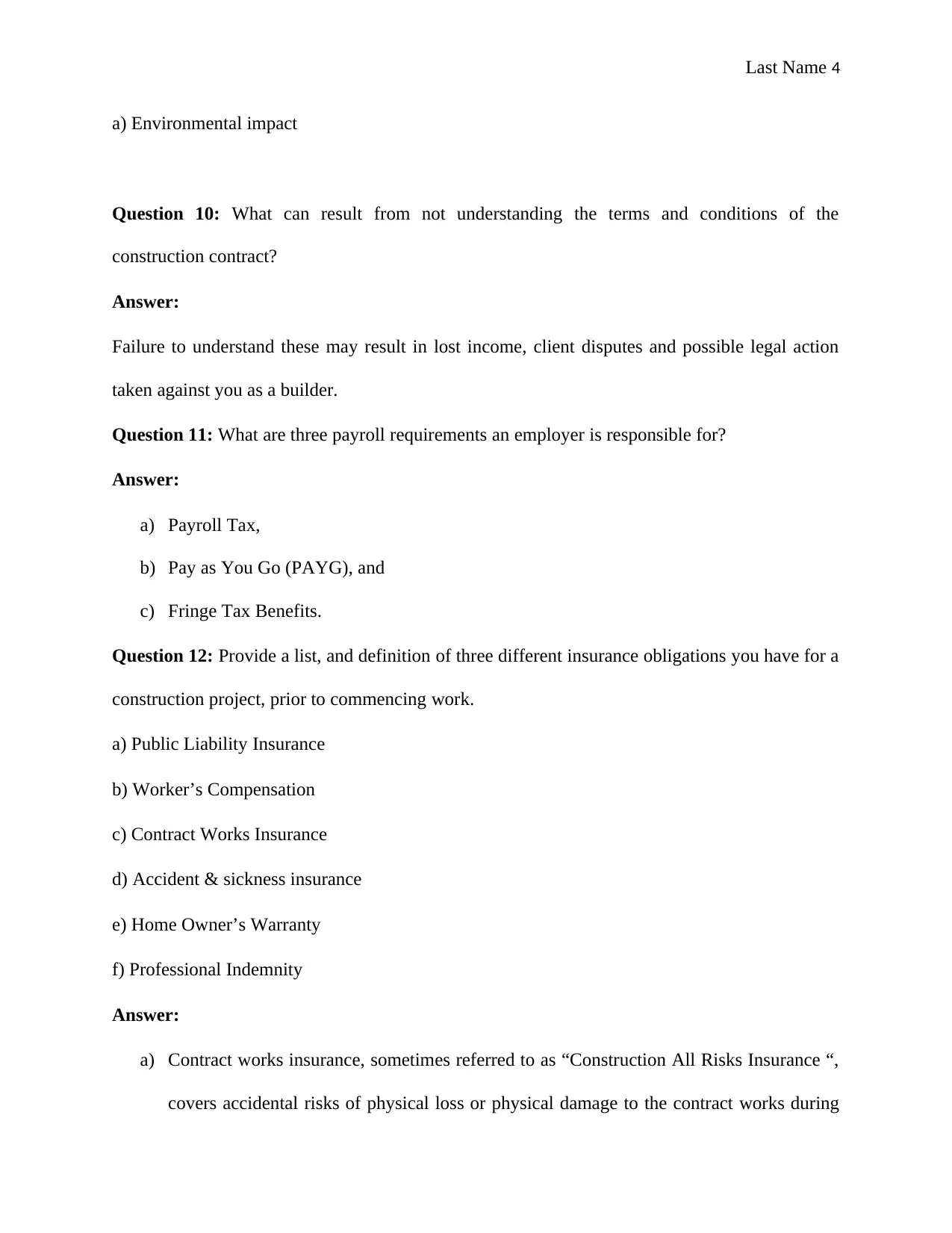
Last Name 4
a) Environmental impact
Question 10: What can result from not understanding the terms and conditions of the
construction contract?
Answer:
Failure to understand these may result in lost income, client disputes and possible legal action
taken against you as a builder.
Question 11: What are three payroll requirements an employer is responsible for?
Answer:
a) Payroll Tax,
b) Pay as You Go (PAYG), and
c) Fringe Tax Benefits.
Question 12: Provide a list, and definition of three different insurance obligations you have for a
construction project, prior to commencing work.
a) Public Liability Insurance
b) Worker’s Compensation
c) Contract Works Insurance
d) Accident & sickness insurance
e) Home Owner’s Warranty
f) Professional Indemnity
Answer:
a) Contract works insurance, sometimes referred to as “Construction All Risks Insurance “,
covers accidental risks of physical loss or physical damage to the contract works during
a) Environmental impact
Question 10: What can result from not understanding the terms and conditions of the
construction contract?
Answer:
Failure to understand these may result in lost income, client disputes and possible legal action
taken against you as a builder.
Question 11: What are three payroll requirements an employer is responsible for?
Answer:
a) Payroll Tax,
b) Pay as You Go (PAYG), and
c) Fringe Tax Benefits.
Question 12: Provide a list, and definition of three different insurance obligations you have for a
construction project, prior to commencing work.
a) Public Liability Insurance
b) Worker’s Compensation
c) Contract Works Insurance
d) Accident & sickness insurance
e) Home Owner’s Warranty
f) Professional Indemnity
Answer:
a) Contract works insurance, sometimes referred to as “Construction All Risks Insurance “,
covers accidental risks of physical loss or physical damage to the contract works during
Paraphrase This Document
Need a fresh take? Get an instant paraphrase of this document with our AI Paraphraser
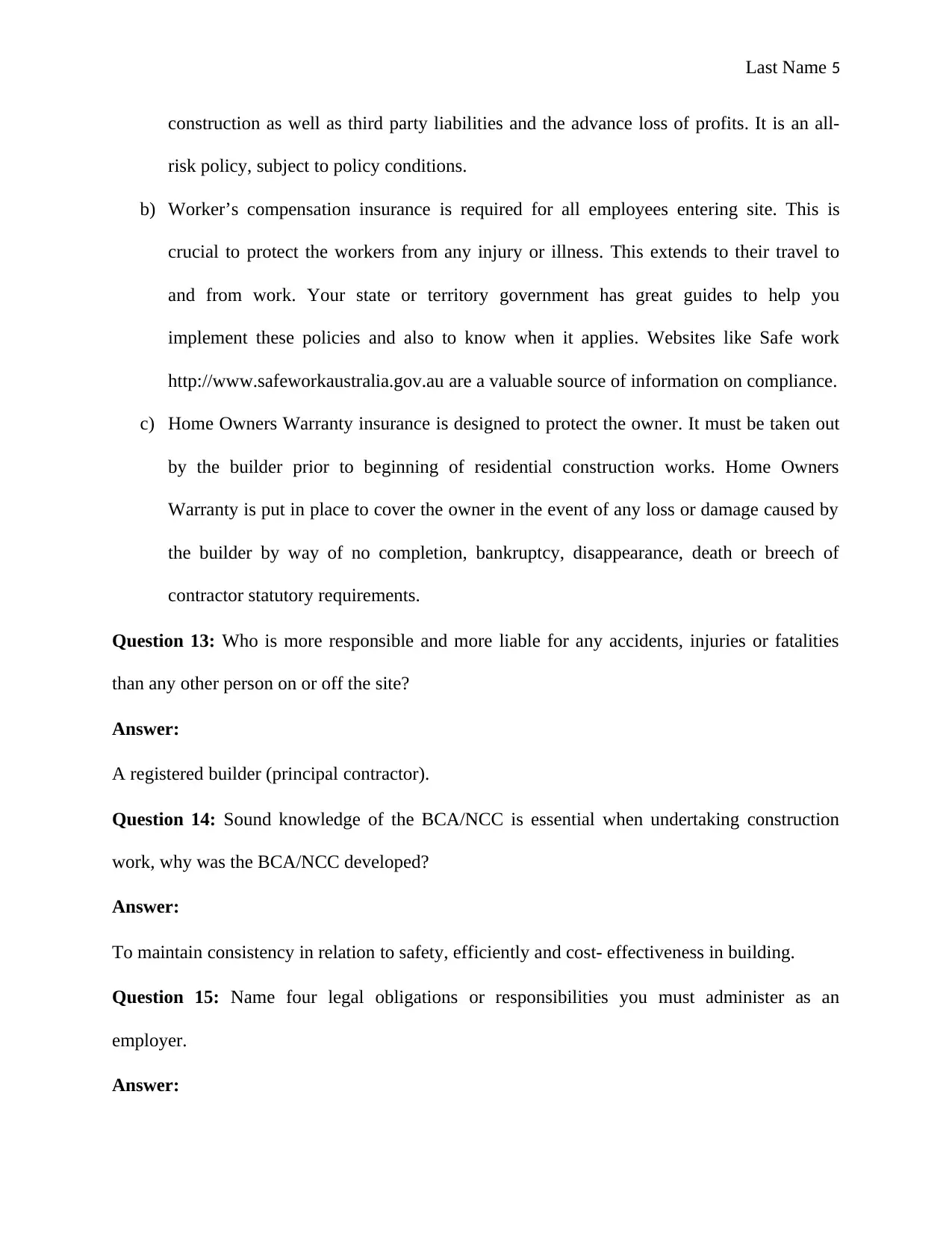
Last Name 5
construction as well as third party liabilities and the advance loss of profits. It is an all-
risk policy, subject to policy conditions.
b) Worker’s compensation insurance is required for all employees entering site. This is
crucial to protect the workers from any injury or illness. This extends to their travel to
and from work. Your state or territory government has great guides to help you
implement these policies and also to know when it applies. Websites like Safe work
http://www.safeworkaustralia.gov.au are a valuable source of information on compliance.
c) Home Owners Warranty insurance is designed to protect the owner. It must be taken out
by the builder prior to beginning of residential construction works. Home Owners
Warranty is put in place to cover the owner in the event of any loss or damage caused by
the builder by way of no completion, bankruptcy, disappearance, death or breech of
contractor statutory requirements.
Question 13: Who is more responsible and more liable for any accidents, injuries or fatalities
than any other person on or off the site?
Answer:
A registered builder (principal contractor).
Question 14: Sound knowledge of the BCA/NCC is essential when undertaking construction
work, why was the BCA/NCC developed?
Answer:
To maintain consistency in relation to safety, efficiently and cost- effectiveness in building.
Question 15: Name four legal obligations or responsibilities you must administer as an
employer.
Answer:
construction as well as third party liabilities and the advance loss of profits. It is an all-
risk policy, subject to policy conditions.
b) Worker’s compensation insurance is required for all employees entering site. This is
crucial to protect the workers from any injury or illness. This extends to their travel to
and from work. Your state or territory government has great guides to help you
implement these policies and also to know when it applies. Websites like Safe work
http://www.safeworkaustralia.gov.au are a valuable source of information on compliance.
c) Home Owners Warranty insurance is designed to protect the owner. It must be taken out
by the builder prior to beginning of residential construction works. Home Owners
Warranty is put in place to cover the owner in the event of any loss or damage caused by
the builder by way of no completion, bankruptcy, disappearance, death or breech of
contractor statutory requirements.
Question 13: Who is more responsible and more liable for any accidents, injuries or fatalities
than any other person on or off the site?
Answer:
A registered builder (principal contractor).
Question 14: Sound knowledge of the BCA/NCC is essential when undertaking construction
work, why was the BCA/NCC developed?
Answer:
To maintain consistency in relation to safety, efficiently and cost- effectiveness in building.
Question 15: Name four legal obligations or responsibilities you must administer as an
employer.
Answer:
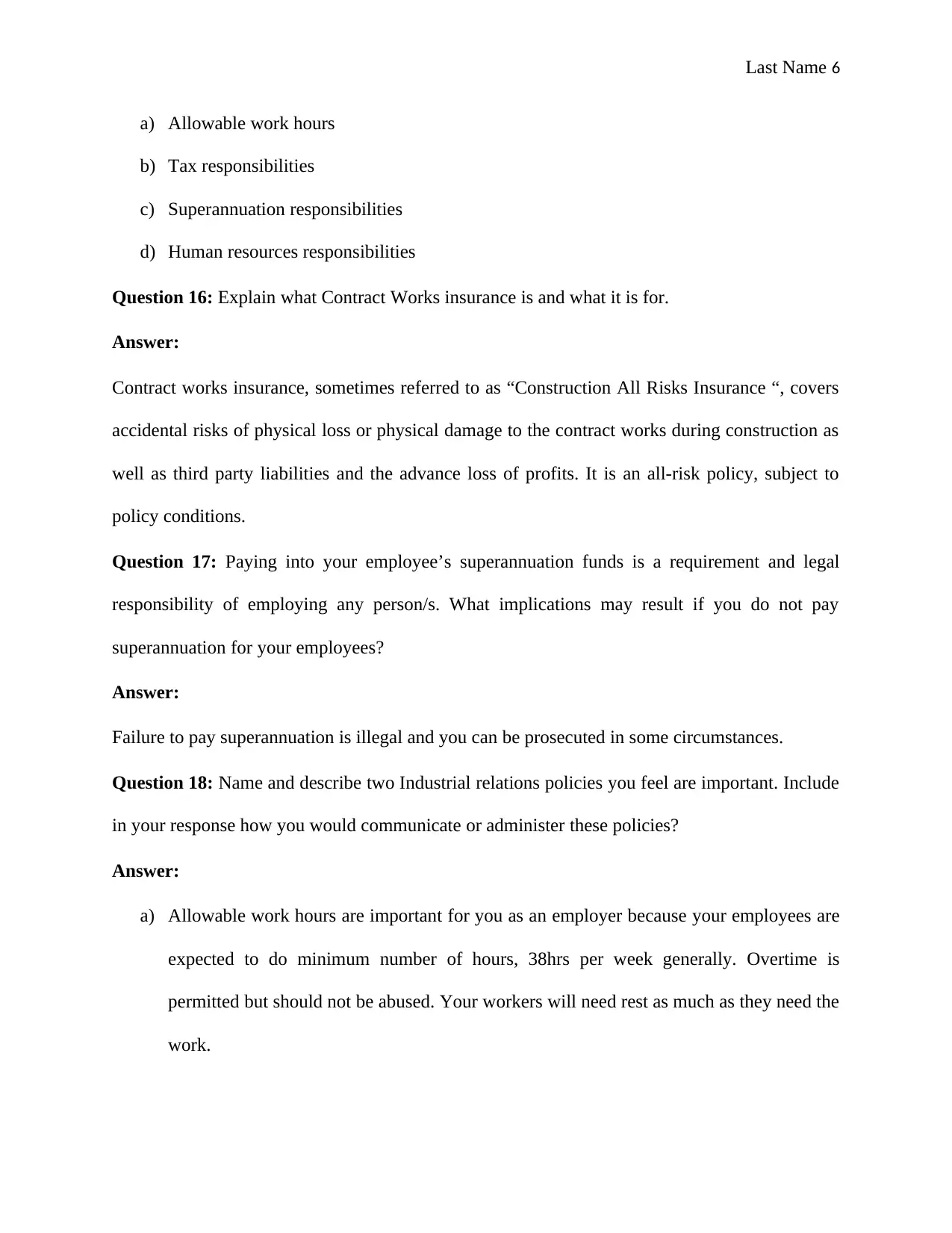
Last Name 6
a) Allowable work hours
b) Tax responsibilities
c) Superannuation responsibilities
d) Human resources responsibilities
Question 16: Explain what Contract Works insurance is and what it is for.
Answer:
Contract works insurance, sometimes referred to as “Construction All Risks Insurance “, covers
accidental risks of physical loss or physical damage to the contract works during construction as
well as third party liabilities and the advance loss of profits. It is an all-risk policy, subject to
policy conditions.
Question 17: Paying into your employee’s superannuation funds is a requirement and legal
responsibility of employing any person/s. What implications may result if you do not pay
superannuation for your employees?
Answer:
Failure to pay superannuation is illegal and you can be prosecuted in some circumstances.
Question 18: Name and describe two Industrial relations policies you feel are important. Include
in your response how you would communicate or administer these policies?
Answer:
a) Allowable work hours are important for you as an employer because your employees are
expected to do minimum number of hours, 38hrs per week generally. Overtime is
permitted but should not be abused. Your workers will need rest as much as they need the
work.
a) Allowable work hours
b) Tax responsibilities
c) Superannuation responsibilities
d) Human resources responsibilities
Question 16: Explain what Contract Works insurance is and what it is for.
Answer:
Contract works insurance, sometimes referred to as “Construction All Risks Insurance “, covers
accidental risks of physical loss or physical damage to the contract works during construction as
well as third party liabilities and the advance loss of profits. It is an all-risk policy, subject to
policy conditions.
Question 17: Paying into your employee’s superannuation funds is a requirement and legal
responsibility of employing any person/s. What implications may result if you do not pay
superannuation for your employees?
Answer:
Failure to pay superannuation is illegal and you can be prosecuted in some circumstances.
Question 18: Name and describe two Industrial relations policies you feel are important. Include
in your response how you would communicate or administer these policies?
Answer:
a) Allowable work hours are important for you as an employer because your employees are
expected to do minimum number of hours, 38hrs per week generally. Overtime is
permitted but should not be abused. Your workers will need rest as much as they need the
work.
⊘ This is a preview!⊘
Do you want full access?
Subscribe today to unlock all pages.

Trusted by 1+ million students worldwide
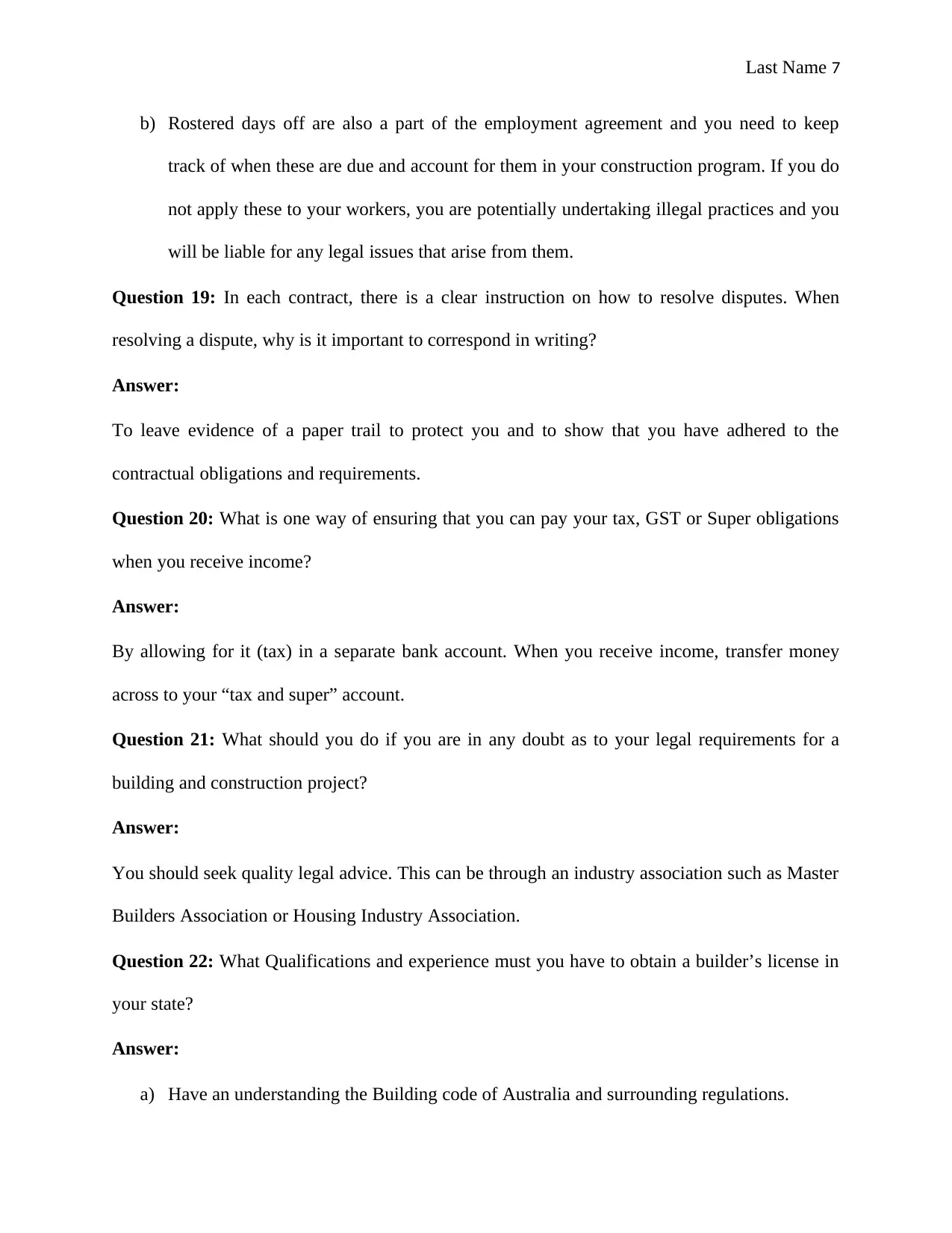
Last Name 7
b) Rostered days off are also a part of the employment agreement and you need to keep
track of when these are due and account for them in your construction program. If you do
not apply these to your workers, you are potentially undertaking illegal practices and you
will be liable for any legal issues that arise from them.
Question 19: In each contract, there is a clear instruction on how to resolve disputes. When
resolving a dispute, why is it important to correspond in writing?
Answer:
To leave evidence of a paper trail to protect you and to show that you have adhered to the
contractual obligations and requirements.
Question 20: What is one way of ensuring that you can pay your tax, GST or Super obligations
when you receive income?
Answer:
By allowing for it (tax) in a separate bank account. When you receive income, transfer money
across to your “tax and super” account.
Question 21: What should you do if you are in any doubt as to your legal requirements for a
building and construction project?
Answer:
You should seek quality legal advice. This can be through an industry association such as Master
Builders Association or Housing Industry Association.
Question 22: What Qualifications and experience must you have to obtain a builder’s license in
your state?
Answer:
a) Have an understanding the Building code of Australia and surrounding regulations.
b) Rostered days off are also a part of the employment agreement and you need to keep
track of when these are due and account for them in your construction program. If you do
not apply these to your workers, you are potentially undertaking illegal practices and you
will be liable for any legal issues that arise from them.
Question 19: In each contract, there is a clear instruction on how to resolve disputes. When
resolving a dispute, why is it important to correspond in writing?
Answer:
To leave evidence of a paper trail to protect you and to show that you have adhered to the
contractual obligations and requirements.
Question 20: What is one way of ensuring that you can pay your tax, GST or Super obligations
when you receive income?
Answer:
By allowing for it (tax) in a separate bank account. When you receive income, transfer money
across to your “tax and super” account.
Question 21: What should you do if you are in any doubt as to your legal requirements for a
building and construction project?
Answer:
You should seek quality legal advice. This can be through an industry association such as Master
Builders Association or Housing Industry Association.
Question 22: What Qualifications and experience must you have to obtain a builder’s license in
your state?
Answer:
a) Have an understanding the Building code of Australia and surrounding regulations.
Paraphrase This Document
Need a fresh take? Get an instant paraphrase of this document with our AI Paraphraser
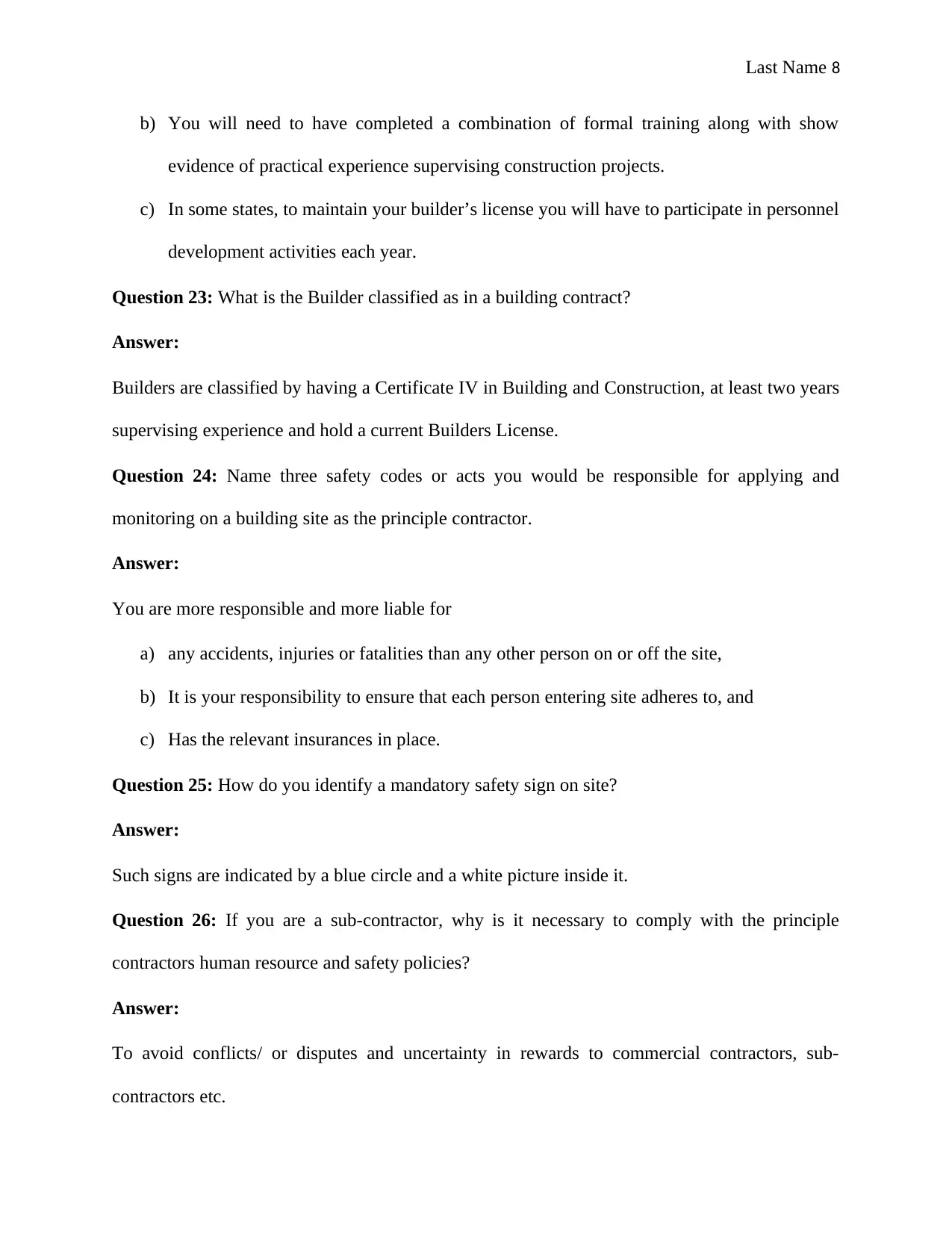
Last Name 8
b) You will need to have completed a combination of formal training along with show
evidence of practical experience supervising construction projects.
c) In some states, to maintain your builder’s license you will have to participate in personnel
development activities each year.
Question 23: What is the Builder classified as in a building contract?
Answer:
Builders are classified by having a Certificate IV in Building and Construction, at least two years
supervising experience and hold a current Builders License.
Question 24: Name three safety codes or acts you would be responsible for applying and
monitoring on a building site as the principle contractor.
Answer:
You are more responsible and more liable for
a) any accidents, injuries or fatalities than any other person on or off the site,
b) It is your responsibility to ensure that each person entering site adheres to, and
c) Has the relevant insurances in place.
Question 25: How do you identify a mandatory safety sign on site?
Answer:
Such signs are indicated by a blue circle and a white picture inside it.
Question 26: If you are a sub-contractor, why is it necessary to comply with the principle
contractors human resource and safety policies?
Answer:
To avoid conflicts/ or disputes and uncertainty in rewards to commercial contractors, sub-
contractors etc.
b) You will need to have completed a combination of formal training along with show
evidence of practical experience supervising construction projects.
c) In some states, to maintain your builder’s license you will have to participate in personnel
development activities each year.
Question 23: What is the Builder classified as in a building contract?
Answer:
Builders are classified by having a Certificate IV in Building and Construction, at least two years
supervising experience and hold a current Builders License.
Question 24: Name three safety codes or acts you would be responsible for applying and
monitoring on a building site as the principle contractor.
Answer:
You are more responsible and more liable for
a) any accidents, injuries or fatalities than any other person on or off the site,
b) It is your responsibility to ensure that each person entering site adheres to, and
c) Has the relevant insurances in place.
Question 25: How do you identify a mandatory safety sign on site?
Answer:
Such signs are indicated by a blue circle and a white picture inside it.
Question 26: If you are a sub-contractor, why is it necessary to comply with the principle
contractors human resource and safety policies?
Answer:
To avoid conflicts/ or disputes and uncertainty in rewards to commercial contractors, sub-
contractors etc.

Last Name 9
Question 27: What award do each of the following fall under?
Supervisor: the Independent Contractors Act 2006.
Apprentice: individual Sub-Contractor Agreement
Sub-contract bricklayer: individual Sub-Contractor Agreement
Question 27: What award do each of the following fall under?
Supervisor: the Independent Contractors Act 2006.
Apprentice: individual Sub-Contractor Agreement
Sub-contract bricklayer: individual Sub-Contractor Agreement
⊘ This is a preview!⊘
Do you want full access?
Subscribe today to unlock all pages.

Trusted by 1+ million students worldwide
1 out of 9
Related Documents
Your All-in-One AI-Powered Toolkit for Academic Success.
+13062052269
info@desklib.com
Available 24*7 on WhatsApp / Email
![[object Object]](/_next/static/media/star-bottom.7253800d.svg)
Unlock your academic potential
Copyright © 2020–2025 A2Z Services. All Rights Reserved. Developed and managed by ZUCOL.





